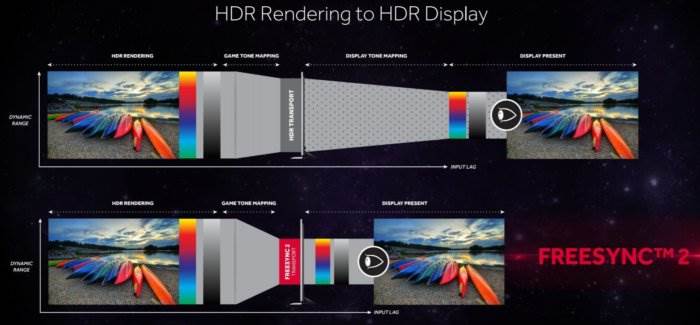AMD’s FreeSync technology—like Nvidia’s G-Sync—was created to smooth out gameplay and eliminate stutter and tearing by synchronizing the refresh rate of your graphics card and your monitor. Now that the technology’s spread to 20 different monitor vendors and over 120 various displays, AMD’s unleashing the aptly named FreeSync 2 to eradicate even more gaming-related headaches—though it’s going to be a cousin, not a successor, to FreeSync itself when the technology rolls out later in 2017.
FreeSync 2 primarily exists to coax the best picture and lowest lag possible out of those drop-dead gorgeous HDR PC monitors that seem poised to make an explosive debut at CES 2017. Rendering high dynamic range visuals is typically a multi-step process behind the scenes. First, the game performs color tone mapping after the engine renders a scene. Then, when the image is passed to the monitor, it’s tone-mapped yet again to fit the display’s supported range.
AMD’s FreeSync 2 API provides the game with the native characteristics of your monitor, which allows it to match your screen’s properties during the game’s initial tone mapping. That eliminates the need for a second pass, and hence, provides the best image possible while also eliminating lag. Win-Win!
 AMD
AMDHow an HDR image is rendered on a standard HDR display (top) vs. on a FreeSync 2 display (bottom).
FreeSync 2 also ensures your game looks as glorious as possible by automatically switching to a “FreeSync mode” that jacks the brightness level and enforces the maximum color space when you boot up a game that supports the technology. The standard Windows desktop can look janky with everything cranked on HDR-quality screens, however, so once you exit the game, the monitor reverts to your preset display configurations. AMD wants all of FreeSync 2’s features to be as plug-and-play as possible.
Fancy-schmancy HDR features aren’t all that you’ll find in FreeSync 2. One of the claims to fame for Nvidia’s G-Sync is that it supports any frame rate, not just a limited selection. FreeSync’s benefits, on the other hand, only work between specified frame rates (30Hz to 75Hz, for example) that vary from monitor to monitor. Late in 2015, AMD rolled out “low framerate compensation” technology that keeps things silky-smooth when your gameplay dips below a display’s supported FreeSync range. Alas, in keeping with the “free and open” FreeSync ethos, LFC is not required in standard FreeSync panels. It’s extra.
That sucks, and it’s not changing for basic FreeSync displays. But LFC is a mandatory requirement for FreeSync 2 certification, along with required low latency levels and a minimum allowed dynamic color and brightness range that’s twice as vibrant as standard sRGB displays. That’s in addition to the goodies in base-level FreeSync, including the new features recently introduced in Radeon Crimson ReLive to help bring the technology’s core feature set closer to parity with G-Sync.
 AMD
AMDAMD’s FreeSync 2 makes Low Framerate Compensation technology mandatory.
FreeSync 2 monitors will be damn good monitors, it sounds like—premium options that more closely rival Nvidia’s costly G-Sync panels than the masses of standard FreeSync displays.
Devils and details
AMD already has testing methodology in place to ensure panels meet those stringent requirements. As opposed to the wide-open world of standard FreeSync support, if a monitor fails to hit those high marks, it will not receive FreeSync 2 certification. In fact, AMD senior fellow architect David Glen says he expects the vast majority of FreeSync monitors will not be FreeSync 2.
Testing and formal certifications aren’t cheap processes, and the FreeSync 2 technology leverages proprietary tech rather than an open standard, akin to the workaround that helped AMD get FreeSync working over HDMI. When I asked Glen whether AMD planned on charging vendors for FreeSync 2 certification, he responded that the company was still looking into potential monetization plans.
 AMD
AMDBut to digress for a second, if FreeSync 2 became a “premium upgrade” of sorts similar to how Nvidia views G-Sync, that would open the door just a bit wider for Nvidia to support basic FreeSync with its GeForce graphics cards, granting Team Green gamers access to delectable variable refresh rate displays at more affordable prices. That would be great for gamers (though it doesn’t sound like Nvidia’s hot to the idea).
Back to FreeSync 2!
Any graphics card that currently supports FreeSync will also play nice with FreeSync 2 via a future driver update. Individual games will need to explicitly support the FreeSync 2 API to take advantage of its feature, Glen said. That’s a bummer, but AMD hopes that the widespread industry support for FreeSync will encourage developers to embrace FreeSync 2. When asked whether there was any way for AMD to force games that don’t support the API to support FreeSync 2’s basic features, Glen played coy but admitted that would indeed be an interesting ability.
So when can we expect to see the first FreeSync 2 displays? Glen hopes it’ll be in the first half of 2017, though he wouldn’t go so far as to promise it. AMD’s already working with multiple panel vendors on multiple projects, so hopefully this hot new tech shows up sooner rather than later. FreeSync 2 monitors sound pretty badass—though because the primary features are tied to maximizing the potential of cutting-edge HDR displays, the first wave will no doubt cost many, many pretty pennies.





![[CES 2026] From Communication to Understanding…Samsung to](https://loginby.com/itnews/wp-content/uploads/2025/12/CES-2026-From-Communication-to-Understanding…Samsung-to-100x75.jpg)

